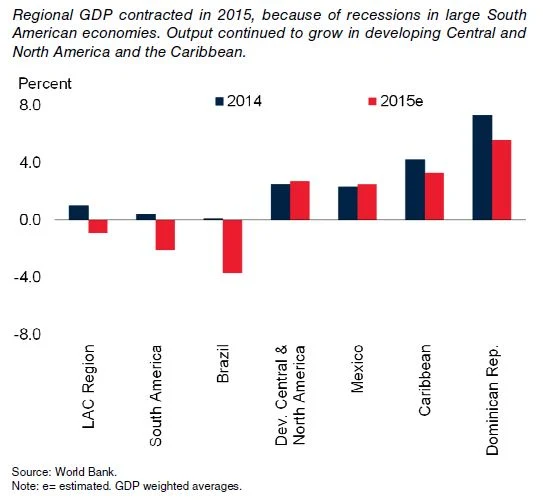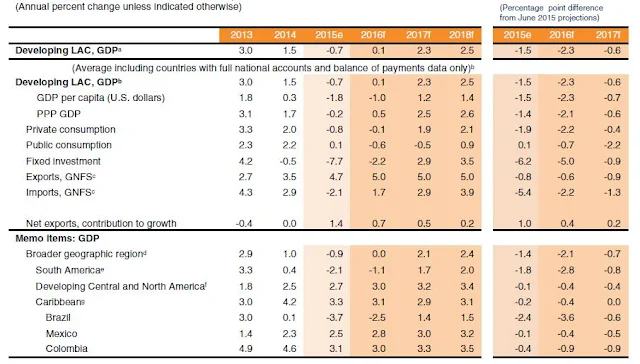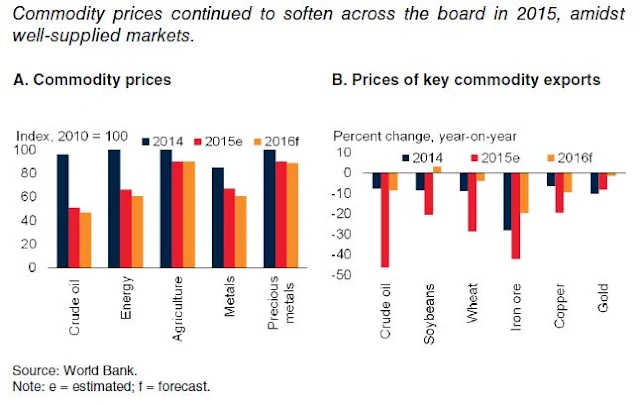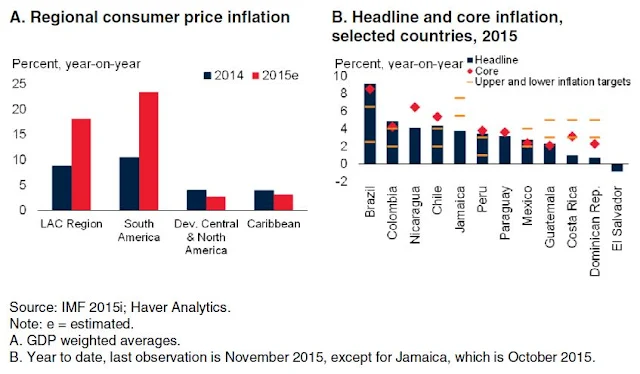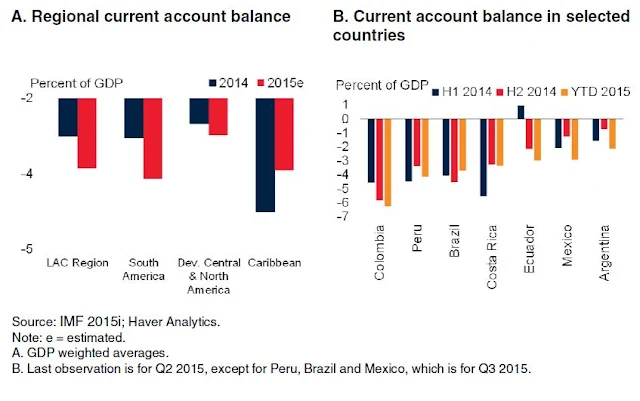Economic activity in the broader Latin America and the Caribbean (LAC) region contracted in 2015. Following three consecutive years of slowing growth, output in the region fell 0.9 percent in 2015,
By World Bank
Economic
activity in the broader Latin America and the Caribbean (LAC) region contracted
in 2015. Following three consecutive years of slowing growth, output in the
region fell 0.9 percent in 2015, partly reflecting sharp declines in economic
activity of large regional economies, such as Brazil and the República
Bolivariana de Venezuela (Table 1, Figure 1).
This reduction in output stemmed from a combination of global and domestic factors, particularly the continued slump in commodity prices. Lower crude oil prices – down around 45 percent from 2014 levels – have reduced export earnings and fiscal revenues of regional oil exporters, such as Belize, Colombia, Ecuador, Mexico, and the República Bolivariana de Venezuela.
Figure 1: GDP growth, 2014-2015
Depressed prices of copper, iron ore, gold,
and soy beans have worsened the terms of-trade for commodity exporters, such as
Brazil, Chile, the Dominican Republic, and Peru. A number of governments had to
undertake pro-cyclical fiscal tightening, aggravating the economic slowdown.
Several large South American economies have also been grappling with severe
domestic macroeconomic challenges that have eroded consumer and investor
confidence, further contributing to the regional output decline in 2015.
Table 1: Latin America
and the Caribbean forecast summary / Source: World Bank
World Bank
forecasts are frequently updated based on new information and changing (global)
circumstances. Consequently, projections presented here may differ from those
contained in other Bank documents, even if basic assessments of countries’
prospects do not differ at any given moment in time.
a. GDP at market
prices and expenditure components are measured in constant 2010 U.S. dollars.
Excludes Cuba, Granada, and Suriname.
b. Sub-region
aggregate excludes Cuba, Dominica, Granada, Guyana, St. Lucia, St. Vincent and
the Grenadines, and Suriname, for which data limitations prevent the
forecasting of GDP components.
c. Exports and
imports of goods and non-factor services (GNFS).
d. Includes the
following high-income countries: Antigua and Barbuda, Argentina, The Bahamas,
Barbados, Chile, Trinidad and Tobago, Uruguay, and Venezuela, RB.
e. Includes
Argentina, Bolivia, Brazil, Chile, Colombia, Ecuador, Guyana, Paraguay, Peru,
Uruguay, and Venezuela, RB.
f. Includes
Costa Rica, Guatemala, Honduras, Mexico, Nicaragua, Panama, and El Salvador.
g. Includes
Antigua and Barbuda, The Bahamas, Barbados, Belize, Dominica, Dominican
Republic, Haiti, Jamaica, St. Lucia, St. Vincent and the Grenadines, and
Trinidad and Tobago.
Output in the
South American sub-region experienced a particularly marked reduction in 2015.[1] With GDP falling in Brazil, Ecuador and the República Bolivariana de Venezuela,
South America saw overall economic growth turn negative, to an estimated -2.1
percent in 2015, after tepid growth in 2014. Investment in Brazil has been
dropping since 2013 due to investors’ loss of confidence, which was exacerbated
in 2015 by the widening investigations into the Petrobras scandal. Monetary and
fiscal tightening, accelerating inflation, and concerns about growing fiscal
deficits also weighed on investment. The República Bolivariana de Venezuela too
is in recession, with very high rates of inflation. Controls that restrict
imports of vital consumer goods and intermediate inputs have curtailed private
consumption and impeded manufacturing. The appreciation of the U.S. dollar has
meant a loss of competitiveness for the fully dollarized Ecuadorean economy.
This, together with lower oil prices, has pushed Ecuador into a recession in
2015. In contrast, Argentina saw activity rebound in 2015.[2] However, the
increase in activity might not be sustainable as it was partly due to a surge
in pre-election public spending, while net exports have been falling and
inflation has been high. Other large economies, particularly commodity
exporters, are continuing to grow at tepid rates.
Despite strong
economic ties to a strengthening United States, developing Central and North
America saw growth rates in 2015 rise modestly from 2014.[3] The sub-region’s
largest economy, Mexico, saw a small pickup in growth in 2015 on the back of
expanding exports to the United States. However, the Mexican economy has been
weighed down by low oil prices and reduced oil production. Lower oil prices
have severely curtailed government revenues, and compelled fiscal
tightening.
Economic growth
in the Caribbean moderated in 2015, with output expanding by 3.3 percent.[4]
The Dominican Republic, the largest economy in the sub-region, experienced a
contraction in mining exports, as prices fell. A surge in investment, including
the construction of new public schools and two new coal-fired power plants,
provided some support to output. In contrast, Jamaica saw growth pick up, amid
increased business and consumer confidence, a successful IMF Extended Fund
Facility program review, and stronger mining output.[5]
The sharp fall
in commodity prices, predominantly due to well-supplied markets, adversely
affected commodity exporters in LAC. In 2015, prices of agricultural products
declined by about 13 percent, metals by 21 percent, and precious metals by 11
percent from 2014 (Figure 2). Oil prices towards the end of the year were
about 45 percent below 2014 prices. This hurt tax and export revenues, and
exerted pressures on fiscal balances of oil exporters (Belize, Colombia,
Ecuador, Mexico, Venezuela). Similarly, the slump in copper prices, along with
the continued slowdown in major trading partners, dampened investment into the
mining sector, weighing on growth in Chile and Peru.
Figure 2: Commodity Prices
Regional
currencies continued to depreciate in 2015. Commodity exporters in the region
saw large depreciations on account of the continued slump in commodity prices
(Figure 3). At end of October 2015, the currencies of Chile, Colombia,
Mexico and Uruguay depreciated by an average of 13 percent in nominal terms and
around 9 percent in real effective terms with respect to their levels at the
beginning of the year. The Brazilian real saw an exceptionally large
depreciation, due to investor concerns about macroeconomic imbalances and
political uncertainty. The Argentine peso depreciated 27 percent on December
17, 2015 when capital controls were lifted.
Figure 3: Exchange Rates
LAC currencies
continued to depreciate against the U.S. dollar in 2015.The depreciation of the
Brazilian real was particularly steep. Because of high inflation, the real
effective exchange rates of Argentina and the Republica Bolivariana de
Venezuela rose, indicating a loss of cost competitiveness.
Regional export
performance improved in 2015, boosted by weak exchange rates and continued
recoveries in the United States and the Euro Area. Regional export volumes of
goods and services climbed around 5 percent in 2015 after remaining broadly
unchanged in 2014 (Figure 4). Exports in South America expanded by about 4
percent, led by Brazil with a substantially depreciated real. Similarly, with
its close ties with the United States, developing Central and North America
experienced export growth of more than 8 percent. Led by strong tourism demand,
the Caribbean’s exports of goods and services rose almost 5 percent in 2015.
Figure 4: Exports
Regional export
performance improved in 2015, boosted by weak exchange rates and continued
recoveries in the United States and Euro Area.
There was a
large divergence in inflation performance across the region. Reduced oil prices
led to lower inflation in developing Central America, North America, and the
Caribbean. For example, despite seeing a 12 percent depreciation of the peso
against the U.S. dollar and being an oil exporter, Mexico’s consumer price
inflation reached historic lows in 2015 (Figure 5). The mild inflation
rates enabled the Banco de México to maintain a record low interest rate of 3
percent for most of 2015 (Figure 6).[6]Inflation pressures in Nicaragua also
eased sharply following a cut in electricity prices in April. El Salvador,
which imports almost all of its oil, saw annual inflation turn negative for
most of 2015. Similarly, consumer prices in Costa Rica fell in the latter half
of 2015, and the central bank further lowered its policy rate to 2.25 percent
in October. Also with low inflation, the Dominican Republic reduced interest
rates and lowered commercial bank reserve requirements in the first half of
2015.
Figure 5: Inflation Rate
Inflation rates are diverging across the countries.
Figure 6: Central bank policy
rates, 2014-2015
Reflecting different
inflation pressures, monetary policies are diverging among countries
In contrast,
consumer price inflation ran at very high rates in Argentina, Brazil, and
especially the República Bolivariana de Venezuela. In Brazil, inflation reached a 12-year high
in the second half of 2015. This was in part due to the one-off effect of a
reduction in subsidies and an increase in administered prices, but the main
reason was higher underlying inflation, as the core inflation accelerated to
above 9 percent. In a series of upward adjustments, the Banco do Brasil raised
policy interest rates to 14.25 percent, a nine-year high. Consumer price
inflation in the República Bolivariana de Venezuela reached well over 100
percent in 2015, as policy has failed to establish an anchor for inflation
expectations.7 Argentina’s.
Inflation in
Colombia is under better control, but has been above the central bank’s 2-4
percent target band since mid-2015. Continued weakness in the peso, along with
a poor harvest of staple crops, contributed to the increase. To guide inflation
back to target, the central bank raised its policy rate in a number of
successive adjustments in the latter half of 2015. Similarly, headline and core
inflation in Peru have been steadily rising and have remained above the
Peruvian central bank’s upper bound target of 3 percent since 2014. This prompted
the central bank to lift the policy rate in September and December.
Fiscal balances
are also on differing paths across LAC. Due to lower commodity and export revenues,
coupled with the slowdown in growth, regional fiscal balances deteriorated, and
the debt/GDP ratio increased in 2015 (Figure 7). Given the large proportion
of major commodity exporters in the sub-region, fiscal balances in South
America as a share of sub-regional GDP are projected to deteriorate by more
than 2 percentage points in 2015. The deficit to GDP ratio for Brazil widened
further, after doubling in 2014. Weak revenues, swelling interest payments, and
losses on central bank dollar swaps, were responsible for the slide. The
Chilean fiscal deficit doubled in 2015. Government revenues have been depressed
by low copper prices. At the same time, the government has boosted public
spending in line with the fiscal stimulus program launched in 2014 to counter slowing
growth. In contrast, Ecuador is projected to see a narrowing of the fiscal
balance in 2015, due to a series of fiscal consolidation measures. Weaker oil
export earnings have led the Ecuadorian government to decrease expenditures by
$2.2 billion in 2015, with cuts almost entirely on capital expenditures.
Figure 7: Fiscal indicators
Fiscal balances are diverging, with
balances deteriorating in South America and improving in the rest of the
region.
Central and
North America, and the Caribbean too saw a narrowing of fiscal deficits in
2015, predominantly due to fiscal consolidation. In Mexico, lower oil prices
and production were offset by a sharp increase in non-oil revenues in the wake
of the tax reform in 2014 and the increase in excise taxes on domestic fuels in
2015. In addition, the government enacted spending cuts equivalent to 0.7
percent of GDP. Supported by the 48-month IMF-supported Extended Fund Facility,
Jamaica introduced new consumption taxes and reduced the public sector wage
bill, as well as sharply lowering gross debt as a share of GDP. After settling
a debt due to the República Bolivariana de Venezuela at a sharp discount, the Dominican
Republic saw a large drop in its debt service costs and registered a
substantial narrowing of its fiscal deficit.
Current account
balances deteriorated throughout most of the region. Despite rising volumes of
total exports, the LAC’s current account deficit as a share of GDP widened to
3.4 percent in 2015 from 2.8 percent in 2014, partly due to reduced export
revenues associated with lower commodity prices (Figure 8). South America’s
current account deficit is estimated to have widened 0.8 percentage point in
2015 to 3.6 percent of GDP. Developing Central and North America saw a smaller
current account deterioration of 0.2 percentage point. As the exception to the
trend, the Caribbean’s deficit narrowed due to elevated tourism receipts.
Colombia saw a current account deficit in the first half of 2015 of more than 6
percent of GDP, due to a plunge in oil export revenues. Similarly, Mexico’s
current account balance suffered from lower oil revenues, owing both to weaker
prices and declining production. However, this was offset by strengthening
export performance of manufactures, which represent a far larger share of
Mexico’s trade and benefited from the weak peso.
Figure 8: Current account balances
Current account balances have
deteriorated in a number of countries.
Gross capital
flows contracted in 2015. Following the sharp slowdown in flows in 2014, gross
capital flows to the region are estimated to have contracted by another 40
percent in 2015 (Figure 9). Brazil and Mexico accounted for around 80
percent of the decline. Weaker-than-expected growth prospects and increased
political uncertainty, especially in Brazil, discouraged investors.
Figure 9: Gross capital
flows
Gross capital
flows declined in 2015.
All three
components of gross capital flows declined in 2015, with equity issuance
contracting the most, falling more than 60 percent. Bond issuance slumped more
than 40 percent from 2014 levels, mainly on account of a $35 billion decline in
new Brazilian bonds. Other economies took advantage of the still favorable
global monetary conditions to put in place refinancing and pre-financing
arrangements. In April, Mexico sold the world’s first 100-year government notes
in euros, as it locked in lower borrowing costs. Colombia issued $4 billion
worth of bonds. Syndicated bank lending dove by 20 percent, reflecting local
banks’ lower funding needs as regional economies cooled.
The large
decline in bond issuance mostly occurred among corporate issuers, particularly Brazilian
corporate deals. Despite its significant appreciation, the U.S. dollar is still
by far the currency of choice for debt issuance in Latin America. From January
to September 2015, over 80 percent of bonds issued were denominated in U.S.
dollars, slightly higher than the same period a year ago.
Sources: Global Economic Prospect 2016 / Download The
Report - LINK
End-Note:
1. The
South American sub-region includes: Argentina, Bolivia, Brazil, Chile,
Colombia, Ecuador, Guyana, Paraguay, Peru, Uruguay, and the República Bolivariana
de Venezuela.
2. Based
on official national accounts data.
3.The
developing Central and North America sub-region includes: Costa Rica, Guatemala,
Honduras, Mexico, Nicaragua, Panama, and El Salvador.
4. The
Caribbean sub-region includes: Antigua and Barbuda, The Bahamas, Barbados,
Belize, Dominica, Dominican Republic, Haiti, Jamaica, St. Lucia, St. Vincent
and the Grenadines, and Trinidad and Tobago.
5. Higher
mining output was led by increased production of alumina, boosted by higher
global demand.
6. The
central bank of Mexico raised its benchmark interest rate by 25 bps to 3.25
percent at its December 17th, 2015 meeting.
7. As
estimated in IMF 2015i.
8. Based
on official data.


